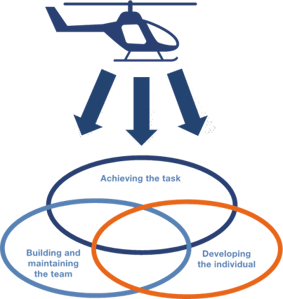
How Should You Lead From A Helicopter View?
As a leader, it can be tempting to get deeply involved in every detail of your team's work, but to do so can stifle creativity and prevent you from focusing on more important, strategic responsibilities. By adopting a helicopter approach to leadership, you can empower your team to work more efficiently and creatively while still keeping control over projects as a whole.
 In this article, we’ll explore this approach and the steps you can take to embrace it.
In this article, we’ll explore this approach and the steps you can take to embrace it.
What is helicopter leadership?
Helicopter leadership or the ‘helicopter view’ is derived from John Adair and his famous Action Centred Leadership (or 3 Circles) Model. Adair’s model makes the juggling act of being a leader easier and simpler, by identifying 3 key areas that all leaders must focus on, and crucially, balance, in order to lead their teams effectively and achieve long-term success. These areas are:
-
Task: Achieving the task successfully
-
Team: Building and maintaining the team
-
Individual: Developing the individual

Produced by Adair Leadership. Copyright © 2023 John Adair
Imagine you're in a helicopter flying over your team, your role as a leader is to spot what needs your attention, touch down and take action at the appropriate time, and then resume your place in the sky. It is a hands-off approach in which a leader oversees their team from a high level without micromanaging, providing valuable guidance and direction only when needed, empowering their team to execute tasks autonomously.
A helicopter leader focuses on long-term goals and strategy, trusting their team implicitly to handle the day-to-day implementation. This approach demonstrates faith in the team's abilities and empowers employees to take initiative and to learn through experience.
How to take a helicopter view when leading teams
So, what steps can you take to be a better helicopter leader?
Avoid micromanagement
Micromanagement is often a symptom of leaders who find it impossible to trust their team and can even be a sign of arrogance. Resisting the urge to micromanage is crucial, as it will instil confidence in your employees that you trust and value them. Giving your team clear direction and expectations is crucial before stepping back to let them do their jobs. Avoid hovering over their shoulders or taking over tasks unnecessarily, as this will undermine morale and productivity.
Carry out periodic checks
Check your team’s progress to assess how things are going. Examine processes and output from a high level across the key areas without getting immersed in the detail. Look for what's working well, and what needs require balancing. By identifying obstacles or where your team specifically needs support, you’ll improve the productivity and efficiency of your team without taking over.
Communicate clearly
When you see opportunities to make changes or reshape your team’s approach, it is essential to communicate clearly and concisely. Say just enough to point your team in the right direction, then allow them to implement changes rather than dictating exactly how they should approach each task.
Recognise success
It’s important to praise your team's progress and successes. A helicopter view allows you to clearly see both team and individual accomplishments, enabling you to effectively recognise and reward your staff. This boosts morale and motivation and helps to reinforce staff retention.
Find out more
A helicopter approach gives your staff space to learn and grow while providing you with context on how their work fits into larger organisational goals. To find out more about Action Centred Leadership click here or download our brochure.


